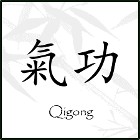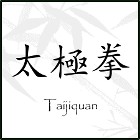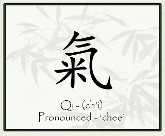Qigong - Taijiquan


The
Health and Wellness world has been flooded with ‘new’ approaches to health and
well being. Many of you have probably seen or heard the terms Qigong, Chi Gung,
Tai Chi Chuan, and/or Taijiquan in fitness magazines, gyms, and wellness
centers everywhere, or even on television commercials. What do they mean? What are they? They sound like Chinese
restaurant items. Can I get them to go?
Very
simply, Qigong and Taijiquan are movement exercises based
on the principles and concepts at the heart of the 5,000 year old tradition of
Chinese Medicine. In that tradition, the body’s innate intelligence
(homeostasis in Western terms) understands what optimal health is and always
seeks to maintain that state. Even if you are unaware of accidentally cutting
yourself, your body will immediately set into motion the healing process. Much
like the needle of a compass always seeking north, the body always strives for
its innate understanding of health and balance. Sadly, WE are the ones who get in the way of that optimal state understood
by the body. Put an obstruction in the way of the compass needle and it will
still try to point north. Remove the obstruction and the needle returns to North. The body, in its attempt to maintain homeostasis,
will compensate for dysfunctional lifestyle choices for only so long before
problems manifest.
The
body, as well as everything in the universe, is composed of energy. And
therefore exists and operates according to certain principles. Einstein and the
school of quantum physics have confirmed scientifically what Eastern Traditions
have espoused for centuries. Understanding the dynamics of energy enables
us to live more efficiently in accordance with one of its basic laws – ‘…the path of least resistance.’
In
the Chinese Tradition energy is referred to as Qi (pronounced – ‘chee’).

In other traditions it is referred to as
‘ki’, ‘prana’, ‘life force’, etc. The concept is the same regardless of the tradition. One of the easiest comparisons
is that of Qi and electricity.
Electricity, when flowing through a light bulb causes the filament to produce
light. When the filament breaks, the glass enclosure shatters, the wiring becomes disconnected, or any of the other factors required for the light bulb to support the flow of electricity fail, the bulb, in effect, dies. The electricity however, returns to its
source and is not affected. Electricity is either 'on' or it's 'not on.' It is never 'off.' Although we understand electricity via its uses, it
remains a mysterious force of nature. So it is with Qi. In the Chinese Tradition, as long as your body’s channels and
pathways are opened, and the Qi is
allowed to flow smoothly, you will enjoy good health. Disease occurs when the
flow of Qi is impeded and cannot nourish the system much the same as our blood
nourishes every cell of the body.
Ancient Chinese saying:
‘When there is no flow, there will be pain.
When there is flow, there will be no pain.’


Qigong (pronounced – ‘chee
gong’) literally translates to ‘energy work’
(Qi = energy, Gongg = work, or time devoted to a skill). The earliest record of movements for
health purposes was a folded piece of silk found in the coffin of King Ma (ca.
168 B.C) on which was drawn four horizontal rows of eleven figures each,
forty-four in all. Depicted on the silk were all the bbasic postures and
breathing postures of current Qigong.
But movement exercise for health and balance had been practiced long before
this discovery, and can be traced back to some of the earliest Dynasties of
China. Many of the earliest Qigong forms were based on the
movements of individual animals – Deer, Bear, Crane, Monkey, Tiger, etc
(Formalized as the ‘Five Animal Frolics’ by
the ‘Divine Doctor’ Hua To during the Han Dynasty 206 BC – 220 AD). Although there are literally thousands of
individual Qigong Forms, or
exercises, the principles are consistent regardless of the style.
- Qigong teaches how to return the body
to correct structural alignment; opposing gravity properly which results
in stronger, denser, and overall healthier bones.
- As the body
returns to proper alignment, areas of chronic muscular contraction are
located, and one learns how to release the excess tension most carry with
them daily.
- Qigong teaches proper breathing which
allows the entire body to switch from highly excited and over stimulated
adrenal-based breathing patterns to more relaxed, calmer endorphin-based
breathing.
- Qigong retrains the body’s
bio-mechanics. Most muscular problems arise from improper movement
patterns. Be it bending and lifting improperly, sitting incorrectly for
extended periods, or throwing out that back for no apparent reason,
improper bio-mechanics is usually the culprit.
The
Qigong Forms (exercises) are simple,
and initially extremely low to no impact movements that can be learned and
performed by anyone regardless of their age and/or fitness level. Qigong can be performed in either standing,
seated, or even lying postures. There is even motionless Qigong. But don't be fooled, there are styles of qigong that will rival any for of intense workout out there today.
 Taijiquan (pronounced Tai –
‘tie’, ji – ‘gee’, quan – ‘chewon’) compared to Qigong, is probably the more familiar of the two activities. The early
morning scenes of hundreds of people performing the fluid, dance-like movements
of the Taijiquan Form in the town
squares and parks of China
conjure images of peace and tranquility. And basically that is what Taiji is – a series of individual
postures that, once learned, are to be executed in a slow, fluid, and connected
manner.
Taijiquan (pronounced Tai –
‘tie’, ji – ‘gee’, quan – ‘chewon’) compared to Qigong, is probably the more familiar of the two activities. The early
morning scenes of hundreds of people performing the fluid, dance-like movements
of the Taijiquan Form in the town
squares and parks of China
conjure images of peace and tranquility. And basically that is what Taiji is – a series of individual
postures that, once learned, are to be executed in a slow, fluid, and connected
manner.
Taijiquan literally translates
to ‘Grand Ultimate Physical Culture.’
Taiji shares the same concepts and
principles as Qigong, and one can
view Taiji Forms as long Qigong Forms. But Taiji has broader applications as it was attributed to being
founded by Zhang San-Feng (born April
9, 1247) as more of a martial art. The graceful movements, when
cultivated through years of dedicated practice, can be utilized as one of the
more deadly martial arts. Different families (Chen, Yang, Wu, and Sun, being
the basic four) developed the different styles (interpretations of basic postures common to all styles) of Taiji that have been taught over the years. Each style has its own
unique variation but, as with Qigong,
all styles are based on and utilize the same basic principles.
Benefits
of Qigong/Taiji
- Stress
Management
- Improved
circulation
- Improved balance
- Increased immune
function
- Improved range
of motion
- Improved digestion
and elimination
- Better quality
and duration of sleep
- Improved
respiratory function
- Improved bone
and joint health
- Improved
concentration and focus
- Improved
coordination
- Pain management
Frequently Asked
Questions:
"I don’t know anything
about either Qigong or Taiji. Which one should I start with?"
You
will, or should be learning the same concepts and principles regardless of which you
choose. However, due to the sometimes overwhelming nature of learning the Taiji Form without any previous
experience, we suggest that you begin with Qigong. The movements/exercises are easier and shorter, and usually consist of balanced movements utilizing both sides of the body. But
at the same time you will be learning everything you’ll need to make the smooth
transition into learning Taiji
should you wish to expand your studies. Traditionally Taiji forms are taught to one side and after learning an entire set, the movement are preformed to the opposite side. It’s easier to learn a ballet if you
already know how to dance.
"Do I need to study
both?"
That
depends entirely on your goals. Some people, after spending the necessary time
to cultivate their Qigong, don’t
have the desire to continue on and learn Taiji.
The benefits don’t lie in the particular art studied. The benefits are derived
from the time, energy, and commitment invested in your practice, and more
importantly, how you incorporate what you've cultivated into your daily life. As with any
beneficial personal development undertaking – you get out of it what you put
into it!
"How long will it take
before I start seeing results?"
The
question of time=results is always dependent on what you are looking to achieve
or correct. Results vary depending on the individual and any preexisting conditions
they may have. The benefits are derived from the time, energy, and commitment invested
in your practice. However, they are not a ‘quick fix.’ Time and effort will be
required. Many of the problems we encounter as we age are the result of years
of improper, or less than desirable, life style choices and therefore can not
be rectified with a few classes. There is no question as to whether Qigong and Taiji 'work'. The question is whether you will make them work for
you! The operational principle in the phrase ‘lifestyle changes’ is CHANGE.
Until we acknowledge and work to address the dysfunctional aspects of our lives
nothing will change. A few wise words to
ponder from Albert Einstein:
‘You
can’t solve a problem with the same mind that created it.’
&
‘Insanity:
doing the same thing over and over again and expecting different results.’
As
with any beneficial personal development undertaking – results are
directly proportional to applied and focused effort! However, you will never truly understand
anything until you experience it for yourself. In the words of Alan Watts:
“You
can’t get wet from the word water.’
"I’m a practicing
martial artist looking to further my studies will Qigong or Taiji enhance what I already know?"
Yes. The
Chinese Arts and can enhance and supplement any practitioner’s knowledge
regardless of their style.
"Is this just another
exercise fad, or is there really something to it? Is there any medical evidence
that this stuff works?"
Fads
usually don’t last for 5,000 years. But the only draw back is that it takes
time to realize the benefits offered by Qigong
and Taiji. The unwillingness to
take the time to cultivate things is turning into the downfall of today’s
fast-paced, quick-fix, ‘I-want-it-now’ society. But even taking into
consideration the instant-gratification aspect of human nature, we’re still
talking about Qigong and Taiji after all this time. Must be
something to it! Research
is constantly being conducted as to the viability of Qigong and Taiji as
Complementary Modalities. It is our goal
to change the word ‘Alternative’ into ‘Complimentary.’ The fusion of Western
Medical technology and research with the 5,000 year old Tradition of Chinese
Medicine can hold the future for true health and wellness of our society –
body, mind, and spirit.
"I’ve seen Qigong and
Taiji before and they look really, really slow. I don’t see how they can be
beneficial or even considered workouts."
Don’t
be deceived by the soft and slow appearance of Qigong and Taiji. These
deceptive movements can provide more of a workout than one would expect. And once the principles of alignment,
movement, breathing and relaxation have been cultivated, the forms can be used
as strength training regimens.
Another
aspect of Qigong and Taiji is that they provide the slower
(Yin) form of development needed for a balanced life. Most people’s idea of
exercise and workouts are full-out active (Yang) exercises
(e.g. aerobics, cardio-vascular, weight training, etc.). While necessary, these
exercise regimens focus on having the body operating at increased levels of
respiration, cardio-vascular output, and muscular utilization. If not balanced
by other training regimens (e.g. Qigong
/ Taiji) this accelerated state of operation of the body can lead to a
quicker rate of adrenal burnout and a false sense of development (‘I’m in
really good shape so why do I get sick so often and don’t have the energy I
should?’). Balancing the active (Yang) workout with slower (Yin) activities
such as Qigong and Taiji can actually accelerate the
body’s recovery process between more strenuous workouts:
- Qigong / Taiji teach slower and
deeper abdominal breathing therefore increasing the amount of oxygen as
well as stimulating the endorphin-based parasympathetic nervous system to
promote healing and repair.
- Qigong / Taiji’s slow expanding
and contracting nature of the movements result in the opening, relaxing,
and subsequent releasing of muscular contractions, as well as tonifying
and lubricating connective tissue (tendons, ligaments, joints). Plus the
movements promote better circulation and nerve function.
- Qigong / Taiji’s slow movements
allow you to focus on proper bio-mechanical utilization of the body. Once
understood on the experiential level, there is less risk for injury when
speed and weight are added as they would be in more active (Yang) exercise
regimens.






 Taijiquan
Taijiquan